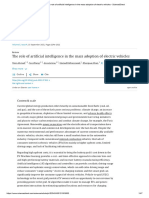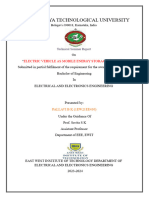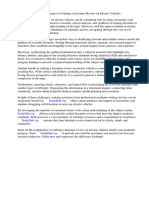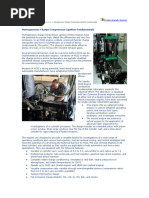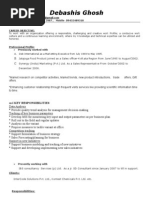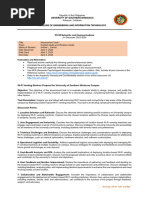Paper 2563
Paper 2563
Uploaded by
namithasetty411Copyright:
Available Formats
Paper 2563
Paper 2563
Uploaded by
namithasetty411Original Title
Copyright
Available Formats
Share this document
Did you find this document useful?
Is this content inappropriate?
Copyright:
Available Formats
Paper 2563
Paper 2563
Uploaded by
namithasetty411Copyright:
Available Formats
ISSN (Online) 2581-9429
IJARSCT
International Journal of Advanced Research in Science, Communication and Technology (IJARSCT)
Volume 2, Issue 1, February 2022
Impact Factor: 6.252
Case Study on Electric Vehicles
Divya S. Tambe, Gayatri V. Adhav, Prof. D.R.Narkhede
Sanjivani K. B. P. Poytechnic, Kopargaon, Nagar, Maharashtra, India
Abstract: The market share of battery electric vehicle (EV’s) is expected to increase in the near future,
but so far little is known about the actual usage of this emergent technology. Consumer preference studies
have indicated that the current limitation on driving distance is important. At the same time studies on the
actual use of household vehicles indicate modest requirement for daily travel. An unresolved issue is to
what extent these range limitation affect daily travel in EVs. In this study, we use real electric vehicle trip
data to supply the distribution of daily use and types of home-based journeys where a household decides
to use an electric vehicle instead of their conventional vehicle. The results show how several factors related
to distance and number of necessary charging events have plausible effects on electric vehicle travel
behavior. Further, the modelling indicates that the EV alternative is mostly used for well-planned transport
and that EV use will not be the same as use of the conventional vehicle in two- vehicle households. Electric
vehicles (EVs) are a promising technology for achieving a sustainable transport sector in the future, due
to their very low to zero carbon emissions, low noise, high efficiency, and flexibility in grid operation and
integration. ... Different types of electric-drive vehicles are presented.
Keywords: EV, BEV, HEV, PHEV, FCEV.
I. INTRODUCTION
Many governments see a greater use of battery electric vehicle (EVs) as an important way to fulfil their environmental
goals. The absence of local exhaust emission can contribute to less local air pollution, and with a higher share of
renewable energy sources in the electricity production, EVs can also contribute to reducing global emission from
transport. However, the environmental impact of large-scale EV adoption is not obvious as it cannot be assumed that
conventional vehicles (CVs) currently on the road are simply replaced by EVs and that individual behavior otherwise
stays the same.
Potential EV users benefits from an increasing availability of EV models with greater comfort and better driving
performance. Furthermore, EVs have the potential to be cheaper to run and maintain than comparable CVs. To obtain
these benefits, however, the consumer must presently accept a limited driving distance between charges and that charging
time, depending on the available facilities where the car is parked, takes minimum 20 minutes for recharging up to 80%
battery capacity and usually several hours to reach full capacity. Therefore, they would need to either find charging
possibilities during the day, which could include detours, or to use other transport alternatives. Both the benefits and
limitations will most likely have an effect on the EV market and it is therefore very useful to know more about potential
users EV travel. Recent decades have provided a number of studies regarding the use of EVs using different
methodologies. Due to a lack of information about actual EV usage, many studies have instead been based on information
about current usage of CVs with the assumption that cars users do not change behavior whether they use a CV or an EV.
Such information has then been obtained from CV odometer readings at refueling, from national travel surveys or from
CV journey measured with GPS.
In this study, we seek to answer how the current technological difference might affect household’ daily vehicle use.
More specifically, we analyses the factors that affect EV use in a different way than CV use and quality how these factors
affect the daily distances driven in a household where both an EV and a CV are available.
Bailey et al, "Is awareness public charging associated with consumer interest in plug in electric vehicles. “Investigation
of whether visibility of public chargers has an impact on PEV Demand. There is no significant relationship between
perceived existence of one charging station and PEV interest [1]. Gyimesi & Viswanathan, "The shift to electric Vehicles.
“Interviews with executives from auto companies and survey of consumers to understand their attitudes towards EVs.
Copyright to IJARSCT DOI: 10.48175/568 644
www.ijarsct.co.in
ISSN (Online) 2581-9429
IJARSCT
International Journal of Advanced Research in Science, Communication and Technology (IJARSCT)
Volume 2, Issue 1, February 2022
Impact Factor: 6.252
45% of the drivers they surveyed have little to no understanding of EVs. Consumers with better understanding are
generally more willing to pay a Premium for the technology. Nevertheless, even well informed consumers are sometimes
unaware of the lifetime fuel savings that EVs offer [2].
II. PROBLEM STATEMENT/ OBJECTIVE
Electric Vehicles (EVs) have often been suggested as a helpful solution to reduce oil consumption and air
pollutant emissions where concerns about oil security and availability and the negative environmental impact of
petroleum-based transportation systems increase.
Create a model to simulate an electric vehicle charging, with the option to alter the parameters to simulate
different EVs
Construct a calculator to generate an annual time-series electric vehicle charging demand for the Ecovillage
residents for different adoption rates
25%, 50%, 75% and 100% of current cars transition to electric vehicles
Simulate the new Ecovillage electrical supply/demand for each adoption percentage
Investigate whether electrical storage or additional generation capacity is required for the Ecovillage according
to the predetermined Key Performance Indicator
Remain a net exporter of electricity
Acquire data on the current Ecovillage electrical demand and residential travel profiles
To learn functionalities and energy efficiency of future EV’s.
Apply the learnings in real time emerging technologies.
Learn Design and Working of EV’s.
To explore the green energy applications.
III. PROPOSED METHODOLOGY
Nowadays, fuel economy and pollutant emissions are keenly felt topics and hybrid electric vehicles (HEVs) represent
the best opportunity to respond to this problem in the short term. Hybrid electric vehicles meet the high-efficiency of
electric motors, with the high reliability of the internal combustion engines, granting optimal results both in terms of
emissions and fuel economy. The vehicle and path features highly affect the architecture choice. A parallel architecture,
having a more flexible layout and providing a higher drive power, is more suitable for long paths and higher speeds,
while the series one better adapts to urban cycles, as can be switched to a pure electric mode.
At the same time, a parallel-series architecture is in general a good choice. Another crucial point is the definition of a
control strategy suitable for the mission the car is expected to accomplish, that must properly control both the load
partitioning, between engine and motors, and the regenerative braking. According to all these considerations, with the
present paper the Authors intend to lay the basis of a comprehensive methodology, which can allow to simply define an
optimized powertrain layout, i.e. architecture and devices size, and an efficient control strategy. To this aim, our research
group has developed an analytical code that simulates the power flows in HEV powertrain and allows to calculate the
performances of a specific vehicle upon various and different missions.
By knowing the energy required, the model allows to define a range of admissible states for each time step, resulting
of the combination of the engine power and the corresponding motor power, considering regenerative braking and
constraints imposed by the engine, the motors and the storage system. The best solution between all possible layouts is
found with Dijkstra shortest path optimization algorithm electing the configuration allowing the minimum fuel
consumption.
Copyright to IJARSCT DOI: 10.48175/568 645
www.ijarsct.co.in
ISSN (Online) 2581-9429
IJARSCT
International Journal of Advanced Research in Science, Communication and Technology (IJARSCT)
Volume 2, Issue 1, February 2022
Impact Factor: 6.252
IV. BLOCK DIAGRAM
V. CONCLUSION
Batteries are being engineered to have a long life. When the hybrid cars become a more widespread, batteries recycling
will become economically possible. Research into other energy sources such as fuel cells are renewable fuels make the
future look brighter for hybrid cars. Hybrid cars are definitely more environment-friendly than internal combustion
vehicles. Importantly, electric vehicles allow you to become energy independent, through the installation of renewable
electricity generation such as a solar array to fuel your car. An electric car makes for a great commuter vehicle. In fact,
if you commute a total of 30-40 miles a day, you’ll probably only have to charge up once a week.
REFERENCES
[1]. Tate, E. and Boyd, S., “Finding Ultimate Limits of Performance for Hybrid Electric Vehicles”, Proceedings of
Society of Automotive Engineers 2000 Future Transportation Technology Conference, August 2000, section on
Hybrid Electric Vehicles
[2]. Friedman, D., 2003, A New Road - The Technology and Potential of Hybrid Vehicles, Union of Concerned
Scientists, UCS publications.
[3]. Smokers, R.T.M. et al., 2000, Annex VI: Hybrid Vehicles Overview Report, Hybrid & electric vehicle
implementing agreement, International Energy Agency.
[4]. Feola, M., Martini, F., and Ubertini, S., “An Analytical Model for Hybrid Vehicles Design,” SAE Technical
Paper2005-24-042, 2005, doi: 10.4271/2005-24-042.
[5]. Rizzoni, G., Guzzella, L., Baumann, B. M., 1999 “Unified modeling of hybrid electric vehicle drivetrains”,
IEEE/ASME Transaction on mechatronics Vol. 4, No. 3.
[6]. MacBain, J., “Simulation Influence in the Design Processor Mild Hybrid Vehicles,” SAE Technical Paper2002-
01-1196, 2002, doi: 10.4271/2002-01-1196.
Copyright to IJARSCT DOI: 10.48175/568 646
www.ijarsct.co.in
You might also like
- Zetwark India PVT LTDDocument11 pagesZetwark India PVT LTDms amith nayakNo ratings yet
- FutureSmart 4 and FutureSmart 5 FirmwareDocument67 pagesFutureSmart 4 and FutureSmart 5 Firmwaresmrizal50% (2)
- Innovation Landscape brief: Electric-vehicle smart chargingFrom EverandInnovation Landscape brief: Electric-vehicle smart chargingNo ratings yet
- Atlas Dolog 20 Doppler Log Manual Skipper Dl1 Multi Is A Single Axis DopplerDocument4 pagesAtlas Dolog 20 Doppler Log Manual Skipper Dl1 Multi Is A Single Axis Dopplersajujohny0% (3)
- Installation and Activation ChessBase 15Document13 pagesInstallation and Activation ChessBase 15Pelaca100% (1)
- Final Project Report (1)Document64 pagesFinal Project Report (1)jsravinpalyaNo ratings yet
- Internet of Things Enabled Electric Vehicles in Smart CitiesDocument8 pagesInternet of Things Enabled Electric Vehicles in Smart Citiespushpa lathaNo ratings yet
- Paper5167Document5 pagesPaper5167swamitanvi89No ratings yet
- International EV Standards PDFDocument25 pagesInternational EV Standards PDFNishit ParmarNo ratings yet
- The Role of Artificial Intelligence in The Mass Adoption of Electric Vehicles - ScienceDirectDocument47 pagesThe Role of Artificial Intelligence in The Mass Adoption of Electric Vehicles - ScienceDirectc b joshiNo ratings yet
- Electric Vehicle Thesis PDFDocument4 pagesElectric Vehicle Thesis PDFWriteMyPaperForMeUK100% (4)
- An In-Depth Exploration of Electric Vehicle Charging Station Infrastructure A Comprehensive Review of Challenges Mitigation Approaches and Optimization StrategiesDocument20 pagesAn In-Depth Exploration of Electric Vehicle Charging Station Infrastructure A Comprehensive Review of Challenges Mitigation Approaches and Optimization Strategiessahani thenuwaraNo ratings yet
- Assignment 1-Elc590Document3 pagesAssignment 1-Elc590MUHAMAD FAIZ AZHARINo ratings yet
- EV PaperDocument5 pagesEV PaperRITHVIKHA VNo ratings yet
- Future of EvDocument15 pagesFuture of Evsakshi.23mbNo ratings yet
- Tech. SeminarDocument8 pagesTech. Seminar7rxbgwtffhNo ratings yet
- Transportation Research Part C: Mojtaba Abdolmaleki, Neda Masoud, Yafeng Yin TDocument20 pagesTransportation Research Part C: Mojtaba Abdolmaleki, Neda Masoud, Yafeng Yin TJosue MarshallNo ratings yet
- Transportation Engineering: Sonali Goel, Renu Sharma, Akshay Kumar RathoreDocument14 pagesTransportation Engineering: Sonali Goel, Renu Sharma, Akshay Kumar RathoreIgoor Morro MelloNo ratings yet
- Oct Riz 24 004Document7 pagesOct Riz 24 004bhaskarNo ratings yet
- Evaluation of Electric Vehicle Component Performance Over Eco-Driving CyclesDocument17 pagesEvaluation of Electric Vehicle Component Performance Over Eco-Driving CyclesPawan DhakalNo ratings yet
- Potential Need For Electric Vehicles, Charging Station Infrastructure and Its Challenges For The Indian MarketDocument6 pagesPotential Need For Electric Vehicles, Charging Station Infrastructure and Its Challenges For The Indian MarketrajeeecvrNo ratings yet
- The Emergence of Affordable Evs ModelDocument3 pagesThe Emergence of Affordable Evs ModelwanyamabrolyneNo ratings yet
- Evs DevanshDocument23 pagesEvs Devanshanmolbansal064No ratings yet
- Storage Technologies For Electric Vehicles: SciencedirectDocument22 pagesStorage Technologies For Electric Vehicles: Sciencedirectnikhil naniNo ratings yet
- IJNRD2404393Document21 pagesIJNRD2404393Alok Kumar YadavNo ratings yet
- Charge Coordination and Battery Lifecycle Analysis of Electric Vehicles With V2G ImplementationDocument11 pagesCharge Coordination and Battery Lifecycle Analysis of Electric Vehicles With V2G ImplementationneeliaNo ratings yet
- Vehicle To Grid TechnologyDocument7 pagesVehicle To Grid TechnologyVIVA-TECH IJRINo ratings yet
- Future Trends in Smart Green IoV Vehicle-to-Everything in The Era of Electric VehiclesDocument20 pagesFuture Trends in Smart Green IoV Vehicle-to-Everything in The Era of Electric VehiclesMarcos Fortaleza de Sousa SilvaNo ratings yet
- Tech 2Document21 pagesTech 2Naveen BosNo ratings yet
- Batteries 10 00103Document21 pagesBatteries 10 00103bhoipranav359No ratings yet
- 9 Renewable-Energy-Integration-With-Electric-Vehicle-T - 2023 - Renewable-and-SustDocument15 pages9 Renewable-Energy-Integration-With-Electric-Vehicle-T - 2023 - Renewable-and-SustMohammad Ashifur RahmanNo ratings yet
- Electric Vehicles: Review On Current Trends, Potential and ChallengesDocument6 pagesElectric Vehicles: Review On Current Trends, Potential and ChallengesAnonymous CwJeBCAXpNo ratings yet
- Necessity of Artificial Intelligence Techniques For Power Quality Issues in Electric VehiclesDocument8 pagesNecessity of Artificial Intelligence Techniques For Power Quality Issues in Electric VehiclesInternational Journal of Power Electronics and Drive SystemsNo ratings yet
- Sustainability on Wheels A Comprehensive Study of Electric Vehicle EV EcosystemDocument10 pagesSustainability on Wheels A Comprehensive Study of Electric Vehicle EV EcosystemEditor IJTSRDNo ratings yet
- 10 35378-Gujs 554206-1121835Document19 pages10 35378-Gujs 554206-1121835Nahil ShakerNo ratings yet
- Electric Vehicle Conversion Based On Distance, Speed and Cost RequirementsDocument9 pagesElectric Vehicle Conversion Based On Distance, Speed and Cost RequirementsVo SantosNo ratings yet
- 2021 Routing Optimization of Electric Vehicles For Charging With Event-Driven Pricing StrategyDocument14 pages2021 Routing Optimization of Electric Vehicles For Charging With Event-Driven Pricing StrategySHIVI TRIPATHINo ratings yet
- Jpee 2022072114404937Document12 pagesJpee 2022072114404937Pundlik KalghatgiNo ratings yet
- Charging Station of Electric Vehicle Based On Iot: A Review: Mahmood H. Qahtan, Emad A. Mohammed, Ahmed J. AliDocument22 pagesCharging Station of Electric Vehicle Based On Iot: A Review: Mahmood H. Qahtan, Emad A. Mohammed, Ahmed J. AliZean LorenzoNo ratings yet
- Preprints201703 0107 v1Document17 pagesPreprints201703 0107 v1Asfand Yar KhanNo ratings yet
- Applied Energy: Amirhossein Ahmadian, Vahid Ghodrati, Rajit GadhDocument12 pagesApplied Energy: Amirhossein Ahmadian, Vahid Ghodrati, Rajit Gadhlawrencesoon86No ratings yet
- CHAPTER 1Document12 pagesCHAPTER 1kamalsurya001No ratings yet
- Research On Impacts of Electric Vehicles Charging and Discharging On Power GridDocument5 pagesResearch On Impacts of Electric Vehicles Charging and Discharging On Power GridAbhinav ShendageNo ratings yet
- Ev Report This Is Electrical Vehicle Notes For All Types of Electric VehicleDocument49 pagesEv Report This Is Electrical Vehicle Notes For All Types of Electric Vehiclejagadeeshyadla2580No ratings yet
- Project Phase 1 - ReportDocument13 pagesProject Phase 1 - Report3035 SURESH KARTHIK JNo ratings yet
- Literature Review On Electric VehiclesDocument8 pagesLiterature Review On Electric Vehiclesea6bmkmc100% (1)
- Impacts of G2V and V2G Power On Electricity Demand ProfileDocument8 pagesImpacts of G2V and V2G Power On Electricity Demand Profilevikram vaidyanathanNo ratings yet
- 1 s2.0 S0378775316313052 MainDocument11 pages1 s2.0 S0378775316313052 MainDamoonAzadNo ratings yet
- Challenges for Electric Vehicle Adoption in BangladeshDocument6 pagesChallenges for Electric Vehicle Adoption in Bangladeshmd sakib nazmusNo ratings yet
- 1-s2.0-S0360544222003401-main_copyDocument11 pages1-s2.0-S0360544222003401-main_copySid DanNo ratings yet
- IeeesiteDocument6 pagesIeeesiteAshish VoraNo ratings yet
- A Case Study On Potential Impact of Electric Vehicle Charging For An Electricity Distribution Utility in IndiaDocument6 pagesA Case Study On Potential Impact of Electric Vehicle Charging For An Electricity Distribution Utility in IndiaDhilly BabuNo ratings yet
- 990b Project PlanDocument5 pages990b Project PlanAshish VoraNo ratings yet
- Electric and Autonomous VehiclesDocument4 pagesElectric and Autonomous VehicleschorrcychenNo ratings yet
- Electric Vehicles in Public Transportation_ Opportunities and ChallengesDocument12 pagesElectric Vehicles in Public Transportation_ Opportunities and ChallengesRishi Raj KanojiaNo ratings yet
- A Study On Perception of Consumers On E - Vehicles in BengaluruDocument16 pagesA Study On Perception of Consumers On E - Vehicles in BengaluruIJRASETPublicationsNo ratings yet
- Base PaperDocument11 pagesBase PaperShruthi SayamNo ratings yet
- Wireless Ev Charging Station On Grid Power Supply, Wind and Solar Power.Document50 pagesWireless Ev Charging Station On Grid Power Supply, Wind and Solar Power.dipakkharate2002No ratings yet
- Electric Cars and EnviroDocument5 pagesElectric Cars and EnviroC VNo ratings yet
- Design and Deployment of Smart-Solar Powered Charge Swap Station For E-Rickshaws With Suitable Software 1-3Document26 pagesDesign and Deployment of Smart-Solar Powered Charge Swap Station For E-Rickshaws With Suitable Software 1-3jamessabraham2No ratings yet
- 98-Article Text-180-1-10-20220510Document12 pages98-Article Text-180-1-10-20220510Ashish VoraNo ratings yet
- 1 s2.0 S2352152X22006697 MainDocument15 pages1 s2.0 S2352152X22006697 MainMohsin Islam RifatNo ratings yet
- 2024 Icaro&CoDocument42 pages2024 Icaro&CooscarvoscarvNo ratings yet
- Progress Report Technical WritingDocument4 pagesProgress Report Technical WritingIza TomNo ratings yet
- عرض تقديمي من Microsoft PowerPoint جديدDocument2 pagesعرض تقديمي من Microsoft PowerPoint جديدمحمد سمورNo ratings yet
- Service Manual - KENZA 240 - V BETA 03-02-2010Document78 pagesService Manual - KENZA 240 - V BETA 03-02-2010ngovantienNo ratings yet
- Welcome Letter Appa BioDocument3 pagesWelcome Letter Appa BioadeNo ratings yet
- MPMC Iii Unit Q&aDocument21 pagesMPMC Iii Unit Q&aswetha bagadi it's good but how it will workNo ratings yet
- Disqualified: Ghana National Fire ServiceDocument2 pagesDisqualified: Ghana National Fire ServicePeter WahabNo ratings yet
- Six SigmaDocument12 pagesSix SigmaNitu KumariNo ratings yet
- E PassbookDocument18 pagesE PassbookNilanjan KarmakarNo ratings yet
- Digi NotesDocument1 pageDigi Notesapi-335851952No ratings yet
- Harmony Control Relays - RM17TT00 PDFDocument6 pagesHarmony Control Relays - RM17TT00 PDFAnton GrozevNo ratings yet
- 11.3 HDLC: 11.2.3 PiggybackingDocument1 page11.3 HDLC: 11.2.3 PiggybackingPetter PNo ratings yet
- Basic Engine D12DDocument11 pagesBasic Engine D12DHamilton Miranda100% (8)
- Group 4 Chapters 1 3 June 16 1Document33 pagesGroup 4 Chapters 1 3 June 16 1Janna Janelle RodelasNo ratings yet
- SCIENCE 5-DLP-March 21, 2023Document7 pagesSCIENCE 5-DLP-March 21, 2023Rachelle PedroNo ratings yet
- LijoDocument2 pagesLijoseminarprojectNo ratings yet
- CAAT ENG 01 Aircraft Maintenance Schedules and Programmes SignedDocument40 pagesCAAT ENG 01 Aircraft Maintenance Schedules and Programmes Signedjakara tongchimNo ratings yet
- Embedded Systems - Theory and Design MethodologyDocument440 pagesEmbedded Systems - Theory and Design Methodologyalex100% (1)
- Ccna 2 v7 Srwe v7 79Document51 pagesCcna 2 v7 Srwe v7 79Riadh SalhiNo ratings yet
- Interactive MediaDocument10 pagesInteractive MediaSiti IzaniNo ratings yet
- SMT Mechanical Suspensions: ROR Trailer ProductsDocument24 pagesSMT Mechanical Suspensions: ROR Trailer ProductsOskarNo ratings yet
- Omnify Sales Process For Swimming Pools by Vipul JhaDocument16 pagesOmnify Sales Process For Swimming Pools by Vipul JhaAshana JhaNo ratings yet
- Meenakshi Sundararajan Engineering College Departmen of Information Technology Aicte-SttpDocument4 pagesMeenakshi Sundararajan Engineering College Departmen of Information Technology Aicte-SttpGS DeviLakshmi KirubaharanNo ratings yet
- L12.1-Dynamic Memory AllocationDocument22 pagesL12.1-Dynamic Memory Allocationmohdaffan0511No ratings yet
- Debashis GhoshDocument3 pagesDebashis GhoshdebashisNo ratings yet
- Networks Assessment Task 1Document12 pagesNetworks Assessment Task 1Adrian GarciaNo ratings yet
- ShravanDocument2 pagesShravanSrinivas ChNo ratings yet









